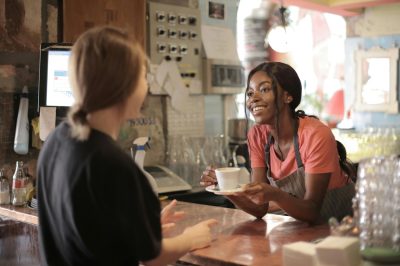Inspiring examples of accessible customer service worldwide

At Bascule, we often talk about the importance of accessibility when serving your customer base, and what steps you can take to become more inclusive. Today we thought we’d show you three exemplary projects we have come across in recent weeks. The following inspiring examples show three companies that are leading the way in creating an innovative and inclusive customer experience, recognising the needs, and improving the service for customers with disabilities.
Please note that we are not sponsored by any of the organisations below, nor are we commenting on any other aspects of how they are run, we simply want to highlight good practice in the disability space…
-
Levi's –
Levi's is setting new standards across a number of its retail outlets by rolling out a new accessible service provided by WelcoMe. WelcoMe is a company that specialises in making face-to-face transactions between staff and customers with disabilities as ‘anxiety-free and friendly as possible’.
By using WelcoMe’s cloud-based service platform, selected Levi's stores can now allow customers with disabilities to plan a visit, and communicate with staff before they arrive, so that they can manage, understand, and assist as per their requirements and needs. Using the technology, customers can add the specific details of their visit, and expected arrival time, ensuring the service they wish for is easily met.
This innovative concept means that the difficulties and challenges that people with disabilities face in retail outlets, can be considered in advance making that visit significantly less challenging.
-
Starbucks-
In February 2024, Starbucks announced its plans to create a more accessible store experience across its U.S. store portfolio through an ‘Inclusive Spaces Framework’.
The first store to demonstrate the framework was opened in February and considered the needs of people with disabilities across the whole building, and all its features. It’s point of sale system (that takes orders and payments), embraces voice recognition to capture customer orders, as well as screen magnification, and images of menu items to support language diversity and visual confirmation of orders.
It has power operated doors from both sides, increased space for wheelchairs, powerchairs, and service dogs, adjustable lighting – including multiple dimmers, acoustic dampening in the ceiling to help reduce noise and reverberations, for those with assisted listening devices, such as hearing aids and an app for people with visual impairments.
The store has put consideration into all features and catered for a broad range of disabilities. Other design considerations include lowered counter height, rounded corners on all surfaces, and remarkably, half the store’s workers know and use ASL (American Sign Language)- which given that the outlet is a short distance from Gallaudet, the nation’s premier Deaf and hard-of-hearing university, is a perfect touch!
Explore the store here
-
Singapore’s Changi Airport
Changi Airport’s overall dedication to accessibility is very impressive. It is committed to ensuring a comfortable travel experience for all passengers. Most recently, it made a greater effort to meet the needs of those who have hidden disabilities by adding a number of new services and recruiting dedicated personnel.
The airport aims to create a completely stress-free travel atmosphere for passengers with non-visible disabilities, by offering an easy to understand, step-by-step customisable guide that passengers use before a visit, called a Social Story. Through images and simple descriptions, this software takes passengers who may for example, be on the autism spectrum, through their travel itinerary, from getting to the airport, to checking-in, boarding and flying- all in advance. This means they can fully understand what to expect before their journey begins. It helps people who have a disability that may experience travel induced anxiety, or cope better with an outline of what is going to happen.
The airport has also appointed 300 staff known as Care Ambassadors, trained to recognise signs and behaviour that may suggest a person has an invisible disability. They have training and experience of how to engage with and approach those with non-visible disabilities, and are trained to use the ‘Observe, Wait, and Listen’ approach – otherwise known as OWL.
People with non-visible disabilities are also able to access lanyards to show they require additional assistance and can use other tools to gain extra support. In order to develop these services, the airport consulted experts from special needs schools and other organisations to better understand their needs and challenges.
Moving forward the airport plans to offer more to those with non-visible disabilities, including a sensory quiet room as well as familiarisation tours for families, prior to their flight.
Final thought
Obviously, some of these inspiring examples are led by larger global organisations, with a considerable budget, but any business can make their service more accessible with some thought and a few simple adjustments, at a low or even no cost. It simply takes consideration, disability awareness, and a little creativity.
For example, many shops or outlets are now offering ‘quiet hours’ where they dedicate a specific moment in the day to customers with disabilities, by turning off music, clearing clutter, dimming the lights and reducing sensory output, to create a more accessible environment. This is a great first step in showing that you are committed to improving your service for people with disabilities- and could potentially be done without spending a penny.



